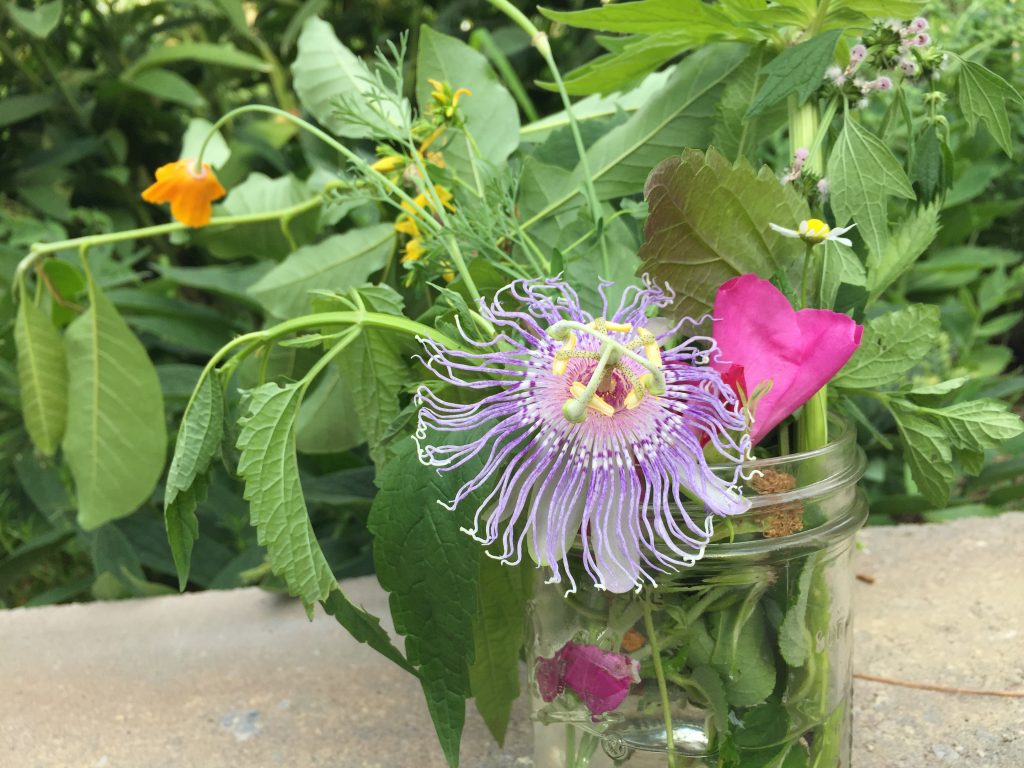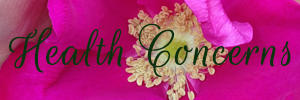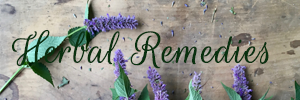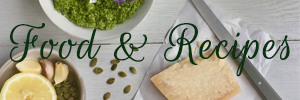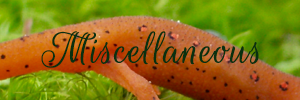Garden Teas to Help You Unwind & Recharge ~
Making and sipping a cup of tea is one of the easiest and most enjoyable self-care rituals. Studies show that simply holding a warm cup (regardless of its contents) makes people friendlier and perceive the world in a better light. Add to that cup some relaxing and restorative teas, and the effects become even more powerful. Step out into your very own tea garden to harvest herbs for that cup of tea, and you’ve discovered how deeply enjoyable plant empowerment can be.
Looking for a tasty cuppa that you can grow easily in the backyard to soothe frayed nerves, help you sleep, or boost your energy? Here are some of my absolute favorites:
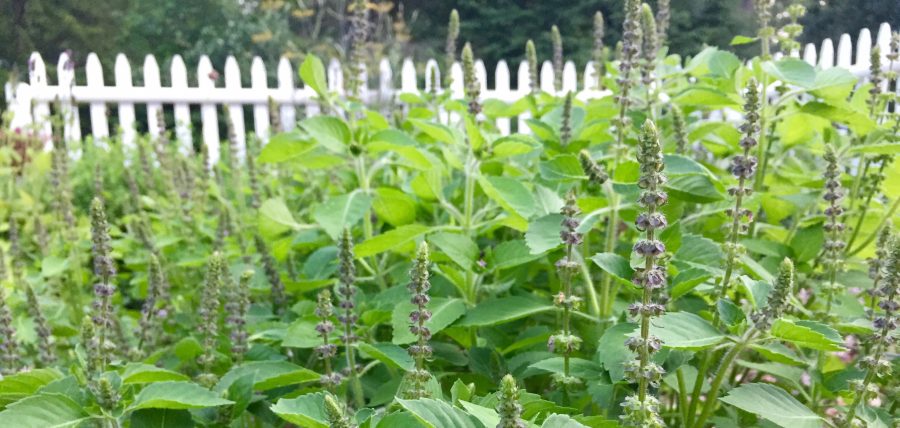
Holy Basil (Ocimum tenuifolium, syn. O. sanctum), also called tulsi, fits almost any niche you might need for your nervous-adrenal system. Aromatic and delicious with heady notes of clove, mint, and bubble gum, holy basil lends itself well fresh or dry to hot and cold water. It quickly calms while gently energizing, with effects that improve if you sip it regularly. As a stress-busting adaptogen, tulsi helps modulate the stress hormone cortisol, which also helps reduce and balance blood sugar. The aromatics improve focus, lift the spirits, ease anxiety. It blends well with other herbs: peppermint for perk, lemon balm for relaxation after dinner, rose to nourish the heart and spirit, and green tea for energy and stable blood sugar with a meal. Grow it as you would culinary basil: primarily as an annual in good soil with regular moisture, good drainage, full sun. An Indian herb, it thrives in hot weather and tolerates containers. Harvest regularly, pinching back and using those prolific flowering stalks. Various species and varieties can be used interchangeably. The Kapoor/temperate (and often unnamed) variety grows most vigorously; new evidence suggests that it’s actually a variety of O. africanum, but most seed sellers still label it as O. sanctum. Homegrown or direct-from-the-farm dried tulsi is vastly superior to what is commonly sold. Check out the full tulsi plant profile (by grad Diana Barkelew) here.
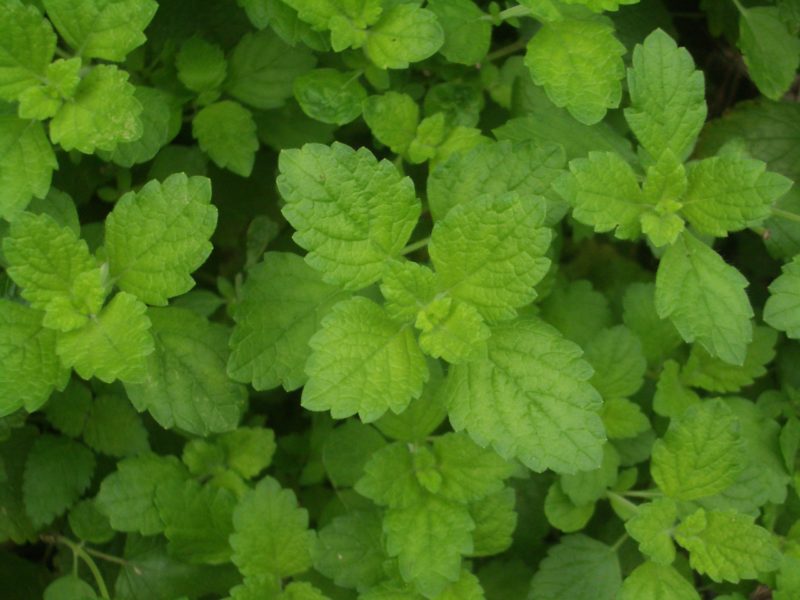
Lemon Balm (Melissa officinalis) is one of the most popular medicinal herbs cultivated in the garden for good reason: the perennial grows prolifically and has many uses. It’s one of the most-revered nervine herbs to nourish and support the nervous system. It quickly eases anxiety and calms frayed nerves, agitation, hyperactivity, anger, and hypervigilance yet it doesn’t over-sedate during the daytime and also uplifts the spirits, gladdens the heart, and focus. Studies have found it useful for memory, attention deficit hyperactivity disorder, and cognitive decline in children to seniors. Fresh or dry, hot or cold, lemon balm’s nice on its own, but it tastes better and is more effective in combination with other herbs: holy basil for a calm-alert state, mint for a pick-me-up, lemongrass or lemon verbena for lemony flavor, skullcap and passionflower for sleep. Dry lemon balm carefully – in a single layer or hanging with good airflow and not too much heat. It loses its lemon pledge flavor pretty quickly once dried. Commercial dried lemon balm pales comparison to the quality of homegrown or direct-from-the-farm. See below for Maria’s podcast videos on lemon balm on Herbs with Rosalee AND HerbRally.
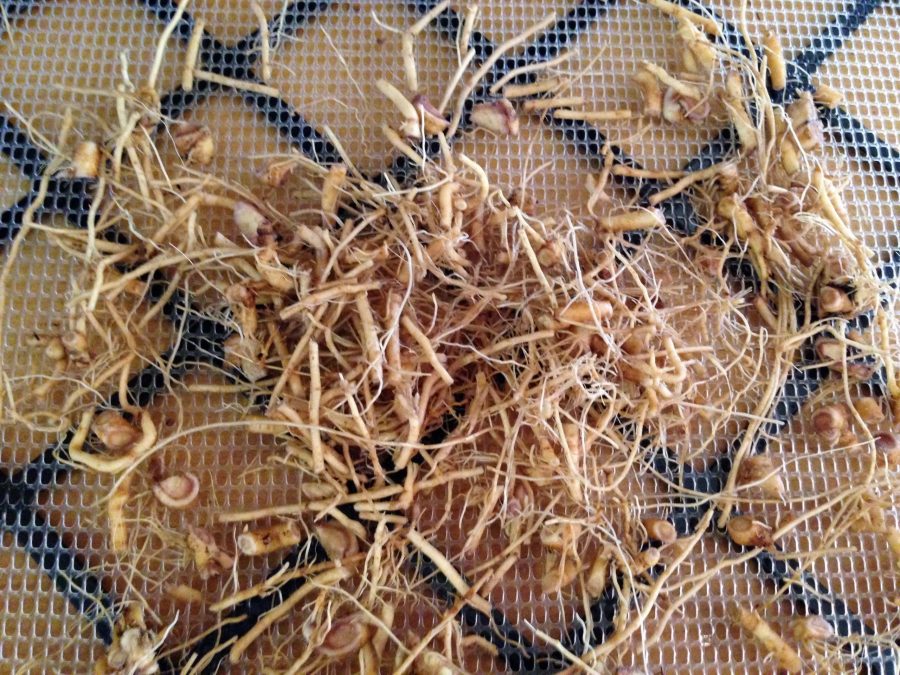
Ashwagandha (Withania somnifera) Compared to the other herbs mentioned in this article, ashwagandha takes a bit more time too grow and a smaller harvest because you’re using the roots. Ashwagandha taken daily promotes deep energy and the strength, vitality (and, yes, libido) of a stallion in men and women. It gently boosts thyroid function and also acts as a nervine. Some people find it helps sleep. Simmer it with chai spices for tea or add the powder to hot milk with honey and nutmeg. This Indian herb from Ayurveda prefers hot, sunny, somewhat dry spots with minimal competition from other plants. The size it reaches is a good indicator of how big the root harvest will be. Dig the roots in fall of the first year in cooler climates (it won’t survive winter) or wait until the second autumn in warmer zones 8 and up. Scrub clean in cold water, chop with clippers, and dry in a single layer in a warm-ish spot with good ventilation or a dehydrator. It stinks as its drying but mellows with time. Once dry, you powder it if desired by grinding in a bullet blender and sift through a fine-mesh strainer. Use caution if you have hyperthyroid disease or are sensitive to nightshade family plants like potatoes and tomatoes.
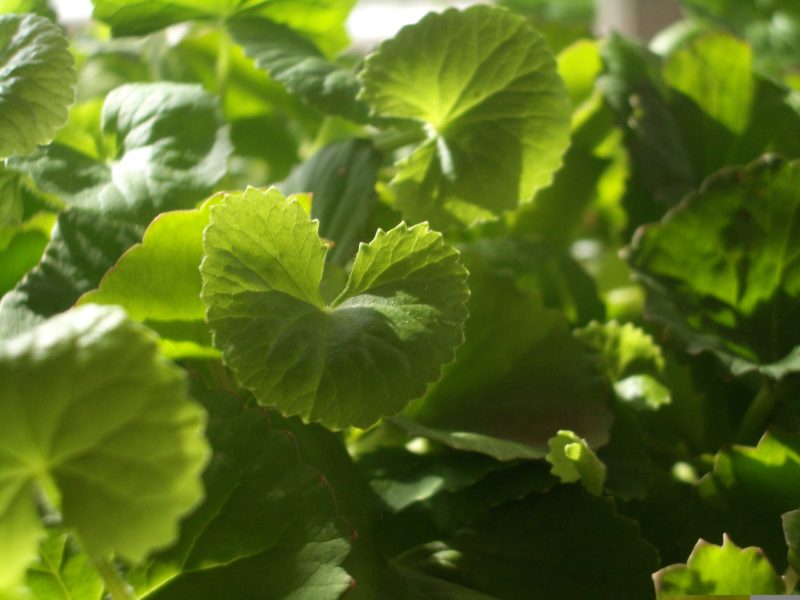
Gotu Kola (Centella asiatica) hails from India and Sri Lanka where it thrives in hot, soggy, rich soil in dappled sun. You can plant it as an annual or keep it in a pot that comes indoors in winter, being mindful to water regularly. Gotu kola offers subtle yet profound benefits that accumulate when taken regularly for months at a time, particularly in high doses (up to an ounce per day). It has gentle stress-relieving adaptogen properties, eases anxiety and jumpy nerves but is most popular for its cognition-boosting and nerve-restorative effects. Rumor has it the elephant’s diet of gotu kola is why the animal has such great memory! You can also eat it fresh or cooked as a leafy green and juice it – popular in its native lands. The flavor isn’t amazing but bland enough to add to flavorful tea herbs (mint, holy basil, lemon balm…) as well as in broths, cooked with garlic and onions, etc. Use the leaves and all aerial parts. See my full profile for gotu kola’s other unique benefits.
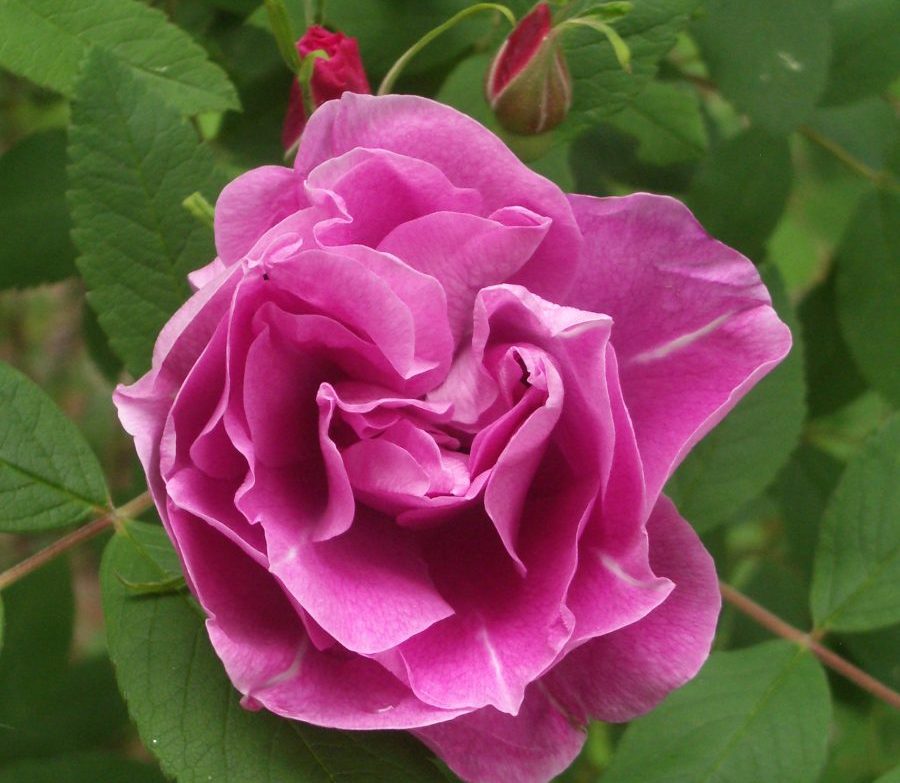
Rose (Rosa spp.) petals add a splash of color to tea blends that lift the spirits and encourage us to be kinder to ourselves. The aromatics also extract well in cold water or seltzer (let a full fresh blossom or two steep for several hours). I infuse them in a glass bottle so I can “stop and see and sip the roses” when I’m busy, stressed, and overworked. Any rose that smells and tastes good and isn’t sprayed will do – typically these are our wild and heirloom species including the moderately invasive seaside (R. rugosa) as well as Damask (R. damascena), apothecary (R. gallica var. officinalis), and cabbage (R. centifolia) rose. Forage invasive multiflora rose (R. multiflora), but don’t plant it. Harvest buds, full blossoms, and fresh petals, preferably early in the day before the heat has cooked out the aroma. Dry buds and petals for tea in a single layer with minimal heat.
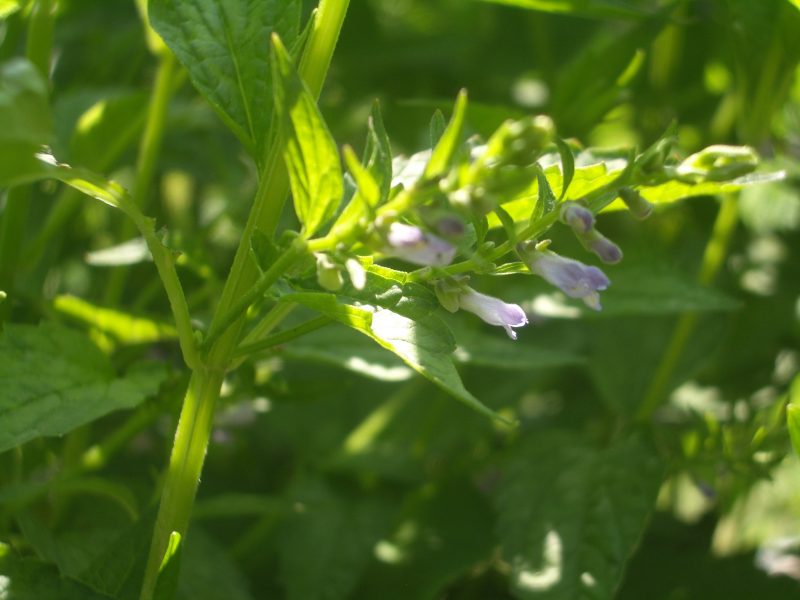
Skullcap (Scutellaria lateriflora) can be persnickety in the garden with good and bad years. This wild plant of the woodland water’s edge (growing amongst wild mint and bugleweed) prefers slightly damp rich-to-sandy soil in partial to full sun. When it thrives, harvest in abundance because it’s so useful and good-quality skullcap is rare on the market. Skullcap has relaxing, nervine properties well-suited for people who feel edgy, anxious, or hyperactive, like the nervous system is in overdrive, when scents, sounds, touch make everything worse. When the sound of your bedpartner’s breathing keeps you from sleeping and oncoming headlights make your migraine feel like someone’s stabbing you through the eyes with an ice pick… skullcap. Combined with more sedative herbs like passionflower, it helps lull you to sleep. Combined with the gentle energizing and focus effects of holy basil or lemon balm, it’s lovely in daytime blends for anxiety. Occasionally (but rarely), regular use can aggravate depression or be too sedating for daytime use. Harvest once aerial parts in bloom and dry carefully to avoid blackening – thin layer or hanging with good airflow, not too much moisture or heat (ideally in the dehydrator at 95-100°F or so).
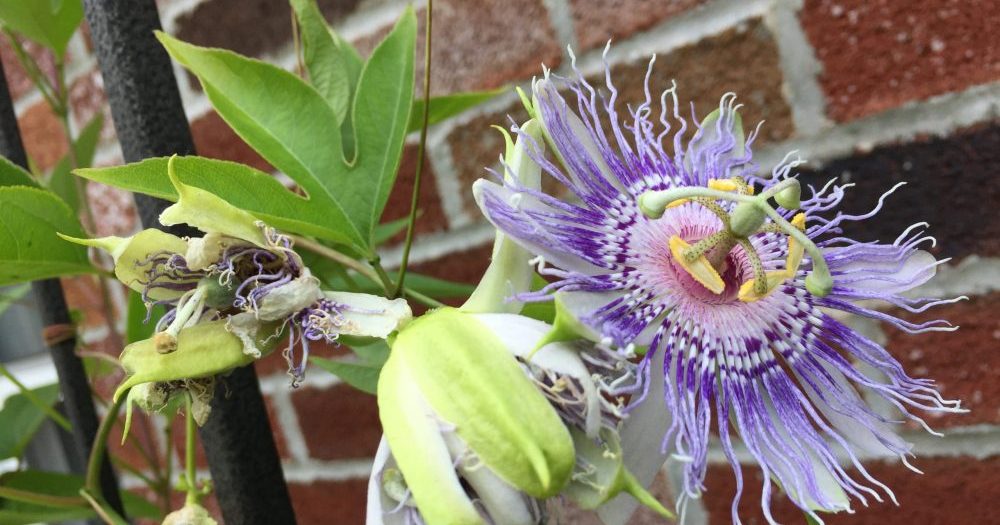
Passionflower (Passiflora incarnata) comes from the southeast where the sprawling vine can be a bit of a pest, but stunning flowers are otherworldly, inspiring missionaries to name it after the Passion of Christ. Passionflower’s aerial parts cool, calm, and sedate. It’s one of our safest and most effective sleep teas (much more pleasant tasting than valerian and hops!), easily enhanced with some spearmint, lemongrass, holy basil, or other flavorful herb. Also consider a little passionflower solo or in blends for anxiety, anger, frustration, agitation, and stress-induced hypertension – just be aware that some people find it too sedating for daytime use. You can cultivate passionflower in a warm, full- to part-sun spot, ambling along a fence, arbor, or trellis, with decent moisture and good soil. It does well in pots and greenhouses as well and can be brought indoors in cooler climates – as a perennial, zone 6 is the edge of its winter-hardy range. Check out Maria’s full passionflower blog post here.
Motherwort
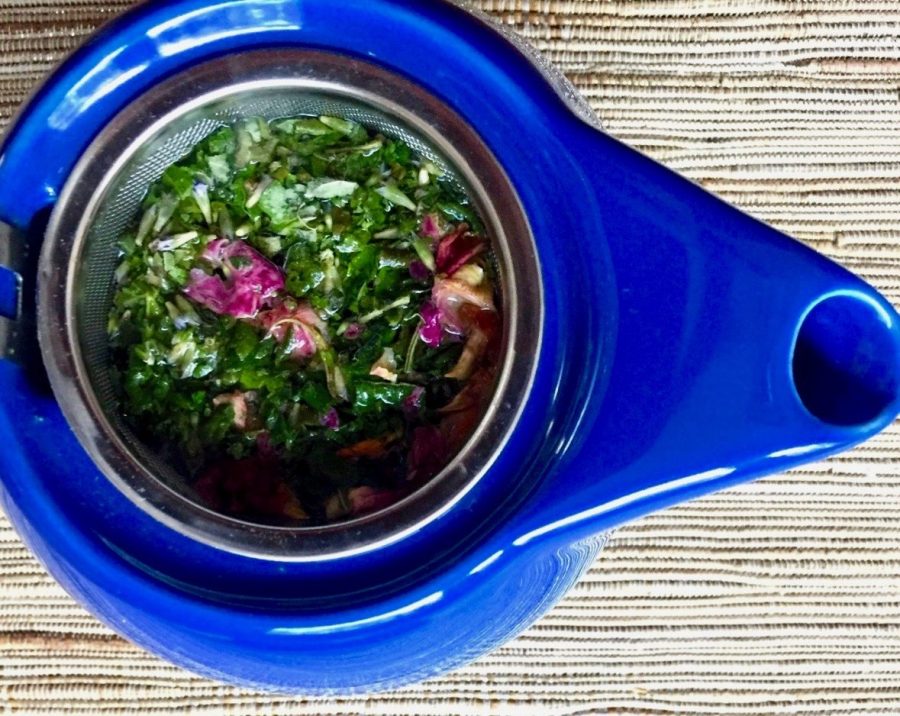
Flavor with Purpose
Alongside your “relax, revive, and restore” tea garden, consider planting tried-and-true flavorful herbs. Though they’re not as overtly specific for the nervous system, they do indeed impact your mood and the medicinal activity of your blends, and they’ll also make them more delicious!
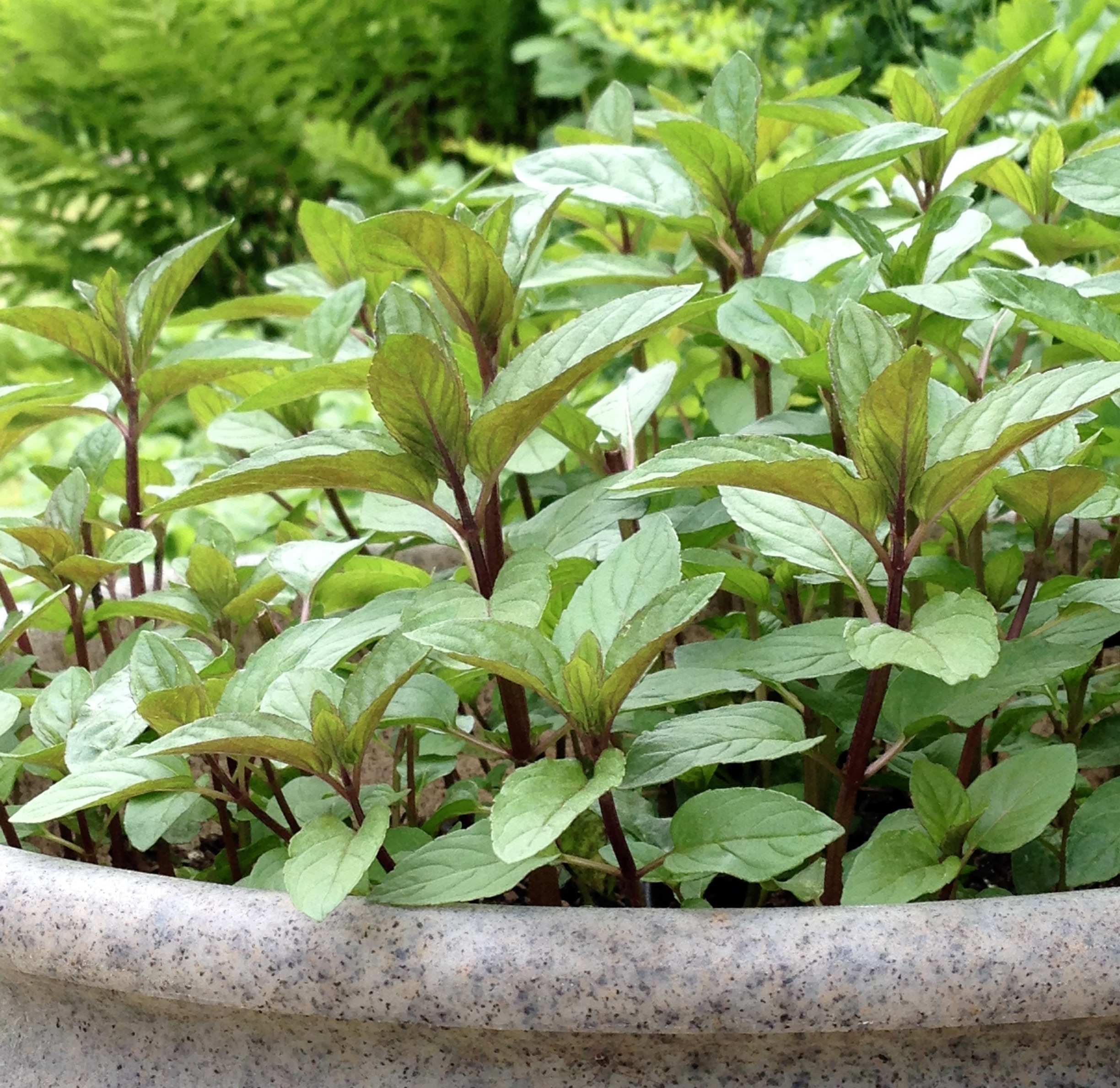
Mint (Mentha spp.) has probably already tucked itself into some corner of your garden – or threatened to take it over with its ambitious and ill-behaved root runners. Perhaps no other herb is as useful for delicious tea blends. Peppermint (M. x piperita) and chocolate mint (a peppermint variety) provide perky-alert properties backed by science. Spearmint (M. spiciata) more gently supports cognition and focus and makes a nice flavoring agent for sleep blends as well. Use apple mint (M. suaveolens) much like spearmint. Feel free to play around with other mints as well – pineapple mint’s quite tasty but may not survive cold winter climates, and my mom loves banana mint. If you haven’t planted mint in your garden yet, bear in mind it spreads and can also interbreed into bland mint hybrids. Consider slowing it down by planting it in big pots or out-of-the-way spots, keeping different species a little ways apart. Lovely in teas fresh or dry, hot or cold.
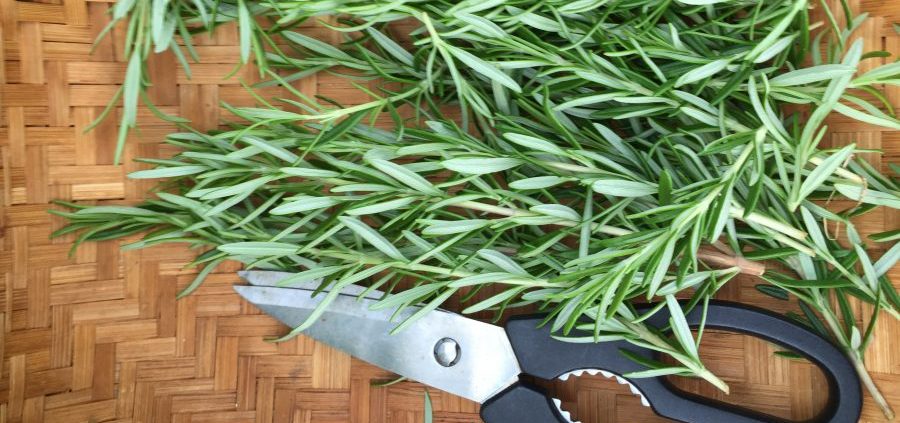
Rosemary (Rosmarinus officinalis), like peppermint, offers perky-alert properties but also has a bit of a bitter, pine-y, resinous edge that adds complexity to tea blends. It’s fine dry but tastes better fresh.
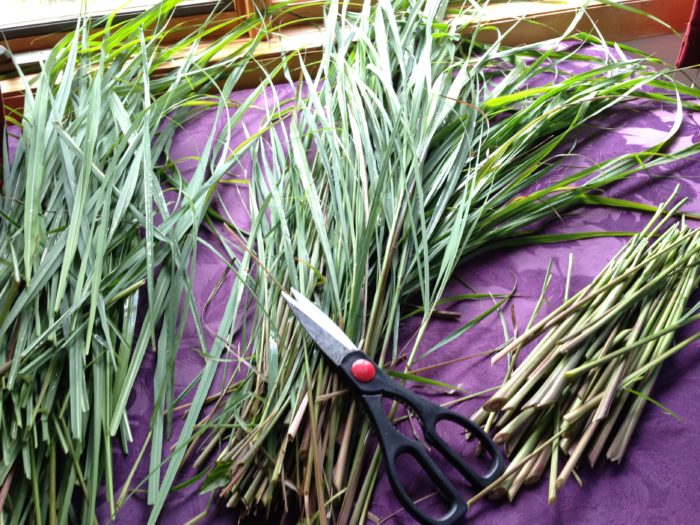
Lemon Verbena and Lemongrass (Aloysia citrodora and Cymbopogon citratus) taste vastly better than lemon balm, adding a pleasant lemon flavor to tea blends that lifts and calms the spirits. Lemon verbena resembles lemon cake (especially if combined with vanilla bean or extract and steeped in not-quite-boiling water) whereas you may recognize lemongrass’ tropical flavor from Thai soups and curry (with a hint of Fruit Loops). Of all the lemon-y herbs, lemongrass holds its flavor the longest but will still lose quite a bit after a year. For tea, dry the grassy tops then cut them into small pieces with sharp scissors – a good activity for a movie night. Freeze the tightly rolled bottom stalks for cooking, cordials, seltzer, and broth. I prefer to keep dried lemon verbena leaves whole to hold their flavor longer, adding a few to my teapot, water bottle, or mug. Both are nice with lemon balm, sleep blends, green tea, or vanilla. Grow these tropical herbs in a pampered garden bed or large pot with full sun, warmth, good soil, and regular water. They don’t like to be crowded by other plants. Be aware that lemongrass can give you a nasty paper cut.
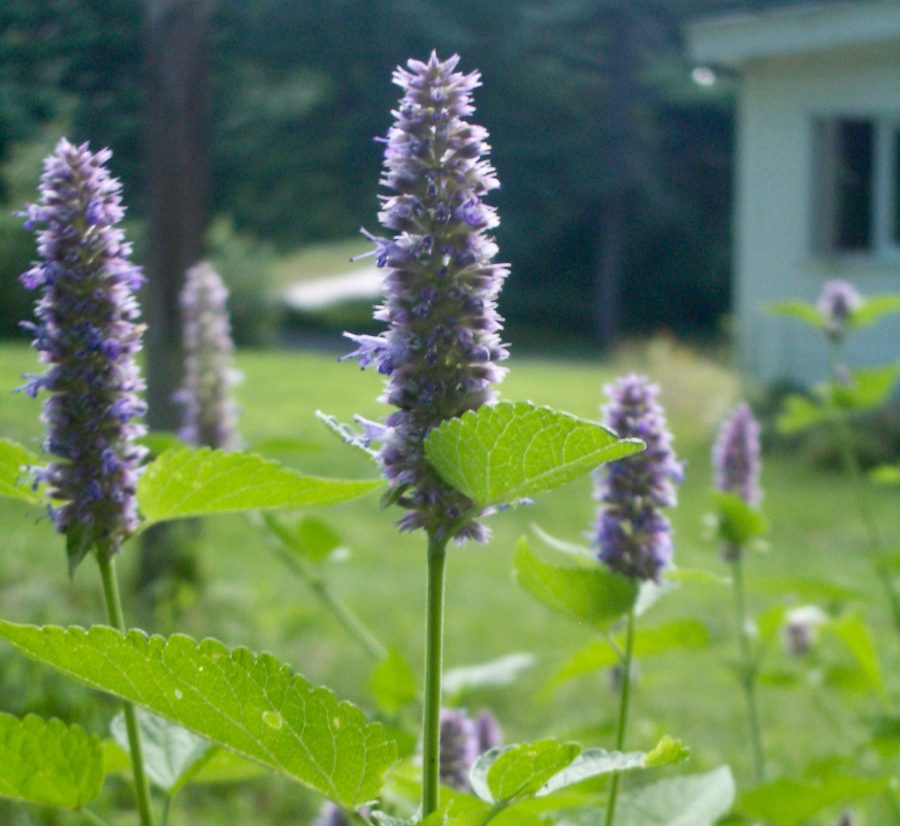
Korean Licorice Mint and Anise Hyssop (Agastache rugosa and A. foeniculum) grow into beautiful purple flower spikes that self-seed all over the garden – but it’s so yummy, pretty, and easy enough to pull up or move that you won’t mind. The two are nearly indistinguishable with a flavor profile ranging from honey-fennel to fennel-mint. Medicinally, this mint-family herb soothes the throat and tummy and has gentle nervine, calming activity. It tastes delicious with almost any other green, leafy herb. It will grow in part shade to full sun – good soil and moderate moisture matters most for big, happy plants. The short-lived perennial will die off after a few years, but by then the babies will be ready to take off.
Harvesting, Drying & Storing Herbs
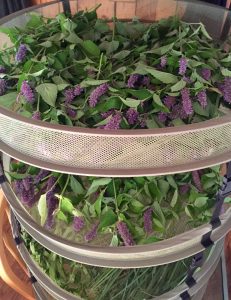 Harvest leaves (with or without flowers) when the plant looks, smells, and tastes the most wonderful, which is usually just before or after it begins flowering. Cut the top 1/3 to 2/3 of the plant, making sure to leave at least a few sets of leaves on the plant. They’re best trimmed right above a leaf note, but you can also grab a bunch of plant material together and give it a “bad haircut.” Keep them on the stem for drying. You can cut lemongrass’ grassy tops for tea this way or (if you want to also harvest the thick stalks for other recipes), cut up to 1/3 of the plant right at the base.
Harvest leaves (with or without flowers) when the plant looks, smells, and tastes the most wonderful, which is usually just before or after it begins flowering. Cut the top 1/3 to 2/3 of the plant, making sure to leave at least a few sets of leaves on the plant. They’re best trimmed right above a leaf note, but you can also grab a bunch of plant material together and give it a “bad haircut.” Keep them on the stem for drying. You can cut lemongrass’ grassy tops for tea this way or (if you want to also harvest the thick stalks for other recipes), cut up to 1/3 of the plant right at the base.
Dry your herbs in a relatively thin or single layer with good airflow until they’re crisp-dry. You can use a dehydrator set to 95 to 110°F for the best results. But good dehydrators are expensive and fill up quickly. Alternately, you can air-dry in bundles or on hanging screens (I’m loving my iPomelo hanging herb-drying rack), but humidity may prevent your herbs from getting totally crisp-dry. You can also loosely pack a brown paper bag with herbs, cinch shut with a clothespin, and leave it in the car windshield on a warm, sunny day (if it’s really hot, place it in a shady spot, a clean trunk, and/or crack the windows). Sensitive herbs like basil, lemon balm, and skullcap may blacken and degrade via the brown bag method due to the heat and reduced airflow – use a dehydrator for them or air dry and then crisp in the car if needed once it’s mostly dry.

Once your herbs are totally crisp dry (no bendy stems!), you can remove the leaves from the stems by stripping with your hands or rubbing over a screen. Store in a clean, air-tight glass jar in a cool, dark, dry spot like a cabinet or pantry.
Fresh vs. Dry? Hot vs. Cold?
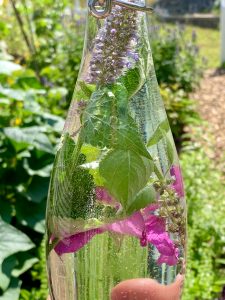 Typically, teas are made with dry herb and hot water. In this form, they quickly and efficiently release their properties. However, a few exceptions can be made. Highly aromatic herbs can be infused in cold water and/or used fresh. Herbs like lemongrass, lemon balm, and lemon verbena lose their flavor so quickly once dried that they’re particularly nice fresh, and holy basil, mint, Agastache species, and rosemary excel fresh or dried. In cold water, you’ll get a lighter tea, but it will be sweeter, more refreshing, and aromatic cold water favors aromatics but not the other constituents in your herbs.
Typically, teas are made with dry herb and hot water. In this form, they quickly and efficiently release their properties. However, a few exceptions can be made. Highly aromatic herbs can be infused in cold water and/or used fresh. Herbs like lemongrass, lemon balm, and lemon verbena lose their flavor so quickly once dried that they’re particularly nice fresh, and holy basil, mint, Agastache species, and rosemary excel fresh or dried. In cold water, you’ll get a lighter tea, but it will be sweeter, more refreshing, and aromatic cold water favors aromatics but not the other constituents in your herbs.
Tea Blends to Try
Sleep Tea: ½ teaspoon each passionflower, skullcap, lemon balm, and spearmint steeped in hot water for 15 minutes in 4-6 ounce teacup and sweetened with honey (Watch a Video on this Blend Here)
Perky Alert Blend: ½ teaspoon each peppermint, spearmint, lemon balm, and gotu kola plus a sprig of fresh rosemary steeped in 16 ounces of hot water for 15 minutes
Happy Day Infused Water: a few sprigs of fresh holy basil and one or two rose blossoms in a glass bottle of cold water, steeped for 2 or more hours (holy basil and rose also blend well hot and/or dry)
Ashwagandha Golden Milk: Simmer 1 teaspoon ashwagandha roots in 16 ounces of hot whole milk, oat milk, almond milk with ¼ to ½ teaspoon turmeric powder, a pinch each of nutmeg and cardamom in for 15 minutes. Strain and add honey or maple syrup to taste.
Ashwagandha Chai: Simmer 1 teaspoon ashwagandha with 2 cinnamon sticks, 2 cardamom pods, 1 star anise pod, and 5 cloves for 20 minutes. Strain and add milk/cream and sweetener ifi desired.
Happy Holy Lemon Tea: Combine equal parts lemon balm and holy basil fresh or dry in hot or cold water, let steep 15 minutes. Exact quantities do no matter – it comes out nicely no matter what!
Good Morning, Tulsi: ½ teaspoon each holy basil and green tea (preferably jasmine green), with a few optional lemon verbena leaves, steeped in 12 ounces of near-boiling water for 4 minutes.
See the gardening hub of my blog and the links page for a list of resources for seeds, mail-order seedlings, and quality from-the-farm dried herbs..Big brands that I love include Gaia Herbs, Wise Woman Herbals, Herbalist & Alchemist, Avena Botanicals, Herb Pharm, Oregon’s Wild Harvest, Mountain Rose Herbs, Urban Moonshine, Traditional Medicinals teas, and Organic India Tulsi teas. Most herb shops, co-ops, and natural food stores carry great herb products, too. But you really can’t beat the quality and potency of fresh from the herb farm or your yard!
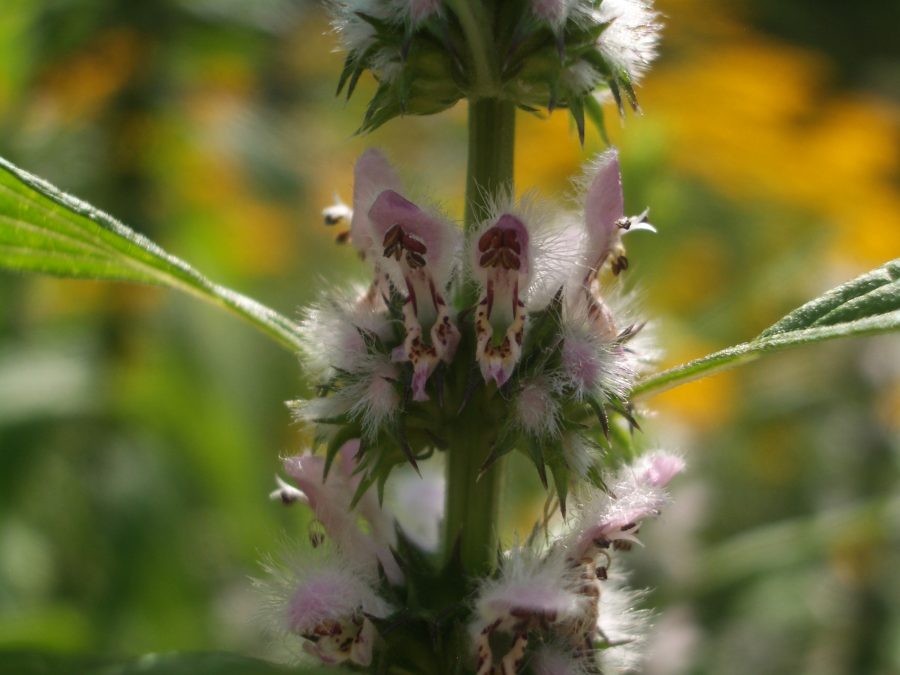
Additional Calming Herbs
So many herbs can be used for relaxation! Chamomile is always a great herb, including as tea, and is easy to grow and find in stores across the world. Kava (as a tincture, tea, or capsule) doesn’t grow in most gardens but is a supreme herb for acute anxiety an panic attack support with studies showing that it can perform as well as some of our most commonly prescribed anxiety medications (and with far fewer side effects. Motherwort is a garden herb that also has fabulous benefits for acute anxiety relief as well as daily support for calm. I love it for folks who are overworked and under-appreciated (this includes at-home parents!), emotional roller coasters, grief and trauma, and stress and anxiety that are felt in the heart. It’s easy to grow, but it’s so bitter and best as a fresh plant, so we most often use it as a fresh tincture. Other herbs include California poppy, wood betony, St. John’s wort, blue vervain, green tea, and more!
Learn More
- Maria’s Lemon Balm Interview + Tincture Recipe on Herbs with Rosalee
- Maria’s Lemon Balm Webinar on HerbRally
- Maria’s Motherwort Interview on Herbs with Rosalee
- Nervines ~ Herbs for Stress: Nourish and Restore the Nervous System
Milky Oat, Lemon Balm, Holy Basil, Gotu Kola - A full set of articles on the benefits of Oat including Milky Oat by Maria in Mother Earth News
- 5 Key Herbs to Relieve Stress and Boost Mood
Ashwagandha, Holy Basil (Tulsi), Milky Oat, Lemon Balm, Motherwort - Motherwort Podcast with Maria Noel Groves & Rosalee de la Foret
- Sleep Better, Naturally Blog + Videos + Additional Resources
- Passionflower Blog with Growing Tips
- Light in the Darkness ~ Herbs to Lift the Spirits & Support Mood
- Building Resistance & Resilience
- Podcast: Perky Calm & Alert Herbs You Can Grow
Clinical herbalist Maria Noël Groves sees clients and teaches classes at Wintergreen Botanicals Herbal Clinic & Education Center in Allenstown, New Hampshire.
The statements made on this blog have not been evaluated by the FDA and are not intended to diagnose, prescribe, recommend, treat, cure, or offer medical advice. Please see your health care practitioner for help regarding choices and to avoid herb-drug interactions.
The article originally appeared in Herb Quarterly magazine.

